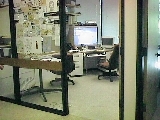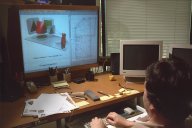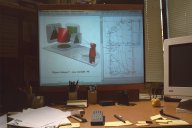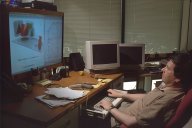- Cleardesk
- Joymaker
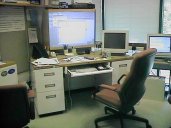
[A History of Digital Equipment Corporation.]
The Big Picture, a Personal View
by Luca Cardelli
1. Science
The ClearDesk project was formulated during a time when many people at SRC acquired three displays on their desks, therefore making their desks completely useless for any other purposes. Well, we said, why not place one or more displays behind the desk, so as to clear up the desk surface? Hence the name of the project.
A display suitable for this use had to be big enough to be readable from behind one's desk. To preserve the customary solid view angle, such a display had to be about 40" diagonal. The only conceivable technology at the time was either front or back projection onto a large piece of glass. Front projection would have required attaching a massive harness to the ceiling, right over my head. After the Loma Prieta earthquake, this was somewhat unappealing. Therefore, we chose back projection. Never mind that this design would consume vast amounts of floor space; the follow-up project, ClearFloor, would fix all that.
A suitable display also had to be bright enough to be viewable under ordinary office lighting conditions, including coping with the summer light shining through our floor-to-ceiling windows. Mighty photons are required under those conditions, much mightier than one can get out of an overhead slide projector or a back-projection TV. Therefore, we chose a bright auditorium projector. It was a small step, from the personal computer to the personal auditorium.
2. Engineering
Our chosen projector (ElectroHome ECP 3000) was no doubt cutting-edge technology. Even without any knowledge of electronics, this fact could be inferred from the frequency with which the electronics failed. Moreover, the manual contained an interesting little footnote: if the light output was cranked up ever so slightly beyond specs, the projector could start emitting soft X-rays! Fortunately, our design provided for a vertically mounted projector with a 45-degree mirror to deflect the light towards the viewer. Soft X-rays go straight through optical mirrors (yes, we asked) and away from the viewer. In any case, we did it for Science.
The next pieces of technology we required were the materials along the optical path. It turns out that a 99% reflectance mirror is just ordinary stuff you can buy in almost any size. More problematic was the choice of the viewing surface. We tested several fancy Fresnel-like sheets of plastic, designed to concentrate light in nice parallel wavefronts instead of scattering it in all directions. Usually, this technique sends most light towards the viewers, making the picture brighter. However, at our unusual viewing distance these materials created a bright hot-spot in the middle of the picture, with most of the light zipping by our ears. We also tested a little piece of F-16 anti-glare cockpit glass (honest!), but this was just too dark and probably beyond our budget. We ended up using the cheapest piece of plain frosted glass we could find. This worked great, giving us equally good viewing from any angle.
So, now we had a state-of-the-art projector, an optical-quality mirror, a piece of cheap frosted glass, and a light path. All we needed was something to hold them in place. Enter the amazing UNISTRUT. This miracle of modern mechanical engineering beats Lego and Fisher-Price hands down. This is an industrial-strength erector set. My early experience with the kiddie version finally paid off. After much cutting and fastening (but no welding!), and much assistance from Chuck Needham, we had a sturdy frame to screw all the rest onto.
Eventually, one ClearDesk projector was assembled. It was designed so that if multiple units were built, they could be adjoined horizontally without any viewing gaps. Three units next to each other would have been fantastic. But I had had enough of mechanical engineering. Moreover, it turned out that the assembled unit was precisely large enough to pass through the door of my office, and I decided not to push my luck any further.
3. Social Impact
A ClearDesk-style display is obviously great for personal enjoyment, for giving demos to large groups of people, and for impressing random visitors. Just as obvious are the facts that focusing at a distance is easier on the eyes, and that a large display is easier to read for people with not-so-good eyesight. However, the ClearDesk projector had other unexpected uses.
First of all, if a job candidate did not comment on the display within 5 minutes of entering my office, that was a clear indication of a non-forward-thinking person. We have little use for such people here.
Second, the ClearDesk display was incredibly useful for cooperative work. A coauthor could sit by my side and comfortably view the paper I was editing, so we could work interactively instead of working on paper or squinting at a regular monitor. In fact, this is the way Martin Abadi and I spent much of our time while writing our book. Martin would use a laser pointer to indicate on the big screen were I should make corrections. Unless, that is, the correction happened to be in lower left corner of the display, because then the laser beam would bounce off the glass into my eyes. Martin was well trained to never, ever point there.
Most of all, I am proud of the fact that, well ahead of the current Carpal Tunnel Syndrom pandemic, we built the ultimate ergonomic computing environment (see this picture). It pleases me to think that if just one person (i.e., me) was saved from CTS and back pain, then my company probably saved millions of dollars in legal fees, therefore compensating for the cost of the project many times over.
4. Decline and Fall
As a research project ClearDesk was very successful, being functional and well over 5 years ahead of the times. After frequent failures in the early years, the projector proved surprisingly reliable. In fact, it was eventually discovered that the electronics failed only when not being used. That is, the projector would work flawlessly for several months during which it would never be turned off. Then a general power failure would cause it lose power. If promptly powered up, everything would be fine. But if the power failure happened over a weekend or while I was in vacation, then, after more than a day of inactivity the projector would be D.O.P. (dead-on-power-up). After that discovery, prompt re-power-ups ensured years of uninterrupted service.
What finally retired the ClearDesk projector was not failing electronics, but rather the relentless march of technology, as well as the relentless stupidity of Apple Computer. For most of its life the projector was connected to a Macintosh, but Apple made it necessary to eventually connect it to a PC. Modern PC's, however, switch resolution at least three times during booting, and this is not a pretty thing to watch on the ElectroHome projector. Moreover, the higher resolutions in use nowadays result in fuzzier pixels on older-technology projectors. So, it eventually came time to rearrange my furniture.
The ClearDesk projector currently rests in our Sub-Forum, where it can still be marveled at. Right above it, in the Forum, a modern large-screen projector dominates the room. Pull up a chair in front of it and pretend, just for a second, to be sitting behind your desk.
It is well known that science fiction writers have not predicted the information age very well (think world-dominating centralized "brains"); it took until William Gibson's cyberspace to get something close to interesting. But in 1965 (firmly in the age of mainframes and wired phones), Frederik Pohl published a story in Galaxy magazine about a future society organized around a personal information device. The story became a book in 1969. I read it probably around 1980, and it remained firmly in the back of my mind. In that novel, The Age of the Pussyfoot, Pohl describes an indispensable device of the year 2527, the joymaker, as "your most valuable single possession". (The story, which is pretty funny, is about a revived 20th century guy who gets into real trouble by not paying enough attention to his joymaker.)
A joymaker is essentially a PDA+cellphone+browser. This is the earliest description I know of a personal connected information device; moreover, the use of the device in the story is very close to the current e-commerce utopia. Pohl is aware of the importance of the idea. In a Foreword he says "I would like to hope that some people will read this book who normally don't read science fiction." And an Author's Note at the back of the book gives some insights on the origin of the idea ("Almost every aspect of it is visible right now, in July of 1968, as a cloud no bigger than a man's hand"), citing Project MAC at M.I.T.: "The console right now can be anywhere a telephone line will go ... My only additional assumption is that it will be convenient to do the same thing by radio." He concludes with "I do not really think it will be that long. Not five centuries. Perhaps not even five decades." We are now in the fifth decade. (But that forecast includes also cryostasis and negative income tax...)
Interestingly, the book includes excerpts of the joymaker's owners manual. These are reproduced here without permission (hey, buy the book, although it's out of print). Some of the details are amusingly current.
The remote-access computer transponder called the "joymaker" is your most valuable single possession in your new life. If you can imagine a combination of telephone, credit card, alarm clock, pocket bar, reference library, and full-time secretary, you will have sketched some of the functions provided by your joymaker.
Essentially, it is a transponder connecting you with the central computing facilities of the city in which you reside on a shared-time, self-programming basis. "Shared-time" means that many other joymakers use the same central computer - in Shoggo, something like ten million of them. If you go to another city your joymaker will continue to serve you, but it must be reset to a new frequency and pulse-code. This will be done automatically when you travel by public transportation. However, if you use private means, or if for any reason you spend any time in the agricultural areas, you must notify the joymaker of your intentions. It will inform you of any steps you must take.
"Self-programming" means that the programmed software includes procedures for translating most normal variations of voice, idiom, accent, and other variable modalities into a computer-oriented sim-script and thence into the mathematical expressions on which the computers operate. As long as your personal joymaker is within reception range of your voice, you may communicate via other shared-time transponders if you wish. Appropriate modulation will be established automatically. However, do not attempt to use another individual's joymaker when yours is not within range. Proper conditioning cannot be assured. In the event that your joymaker is lost or damaged ...
To use your joymaker as a telephone: You must know the ortho-name and identification spectrum of the person you wish to reach. Once you have given this information to the joymaker it will be remembered, and you can then refer to the person in later calls by a reciprocal name or any other personal identification programmed into your joymaker. If you have been called by any person, the joymaker will have recorded the necessary ortho-name and identification spectrum. Simply ask the joymaker to call the person you wish to speak to. If you wish to establish a priority rating with any person, that person must so inform his joymaker. Otherwise your calls may be deferred or canceled as directed by the called person.
To use your joymaker as a credit card: You must know the institutional designation and account spectrum ...
Copyright 1969 by Frederik Pohl. Ballantine Books ISBN 0-345-27129-7.
P.S., Thomas Krul says:
I, too read this story
around 1980 (I was about 13 at the time). Great story that
would actually make a good movie. One thing you and most
reviewers of this story strangely neglect to mention is the
dispension of mood-altering chemicals (aromatherapy that
actually works?) by the Joymaker. You mention a hardcover
version of the book, but this story was also available in a
paperback mini-anthology called "Bipohl" which features only
2 stories: "Drunkard's Walk" and "The Age of the Pussyfoot".
The cover had the protagonist clutching his Joymaker while a
green Sirian alien loomed behind him. If you can find the
paper back version or "Bipohl" it will be closer to $1 than
the $24 quoted for the hardcover.

